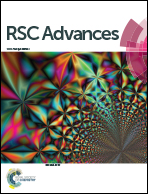Enhancement of solar energy absorption using a plasmonic nanofluid based on TiO2/Ag composite nanoparticles
Abstract
Combined with the solar irradiation spectrum, the optical properties of both TiO2/Ag composite nanoparticles and water-based nanofluids composed of different nanoparticles are studied. The solar energy absorption features are compared among these nanofluids based on TiO2, Ag and TiO2/Ag composite nanoparticles. Due to the localized surface plasmon resonance (LSPR) effect excited on the Ag surface, the optical absorption of TiO2/Ag plasmonic nanofluid is remarkably enhanced. The enhanced absorption by LSPR excitation is introduced in solar thermal conversion. The photothermal experiments of different nanofluids conducted under the same conditions reveal that TiO2/Ag plasmonic nanofluid exhibits a higher temperature compared with that of TiO2 based nanofluid. Although the temperatures of Ag nanofluid and TiO2/Ag nanofluid are the same, the cost of TiO2/Ag based nanofluid is much lower. The effect of nanoparticle concentration on the photothermal performance of TiO2/Ag plasmonic nanofluid is also studied in this paper.


 Please wait while we load your content...
Please wait while we load your content...